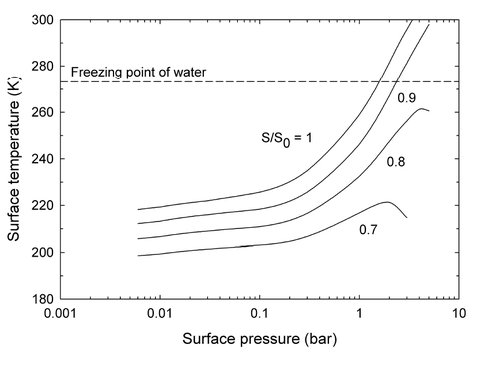2009 Annual Science Report
 VPL at University of Washington
Reporting | JUL 2008 – AUG 2009
VPL at University of Washington
Reporting | JUL 2008 – AUG 2009
Understanding the Early Mars Environment
Project Summary
The surface of Mars today is a cold dry desert on which liquid water cannot exist. Evidence from rovers and orbiters indicate that liquid water may have existed on the surface of Mars in the distant past. This project aims to understand how it could have been warm enough for liquid water by creating computer models of the ancient Mars surface, atmosphere, and climate, and comparing the results with the available data. In a nutshell, we are trying to warm up a computer version of Mars, which is not as easy as it sounds.
Project Progress
NAI DDF award “Volcanic SO2, atmospheric photochemistry, and climate on early Mars”
We have investigated if SO2 gas could warm early Mars as suggested by Halevy et al. (2007). While SO2 is undoubtedly a good greenhouse gas, we have shown that high concentrations of SO2 will inevitably lead to sulfate aerosol formation, which cools the climate (Claire, 2009, Tian et al, 2009). We proposed a novel mechanism for warming early Mars via visible absorption by NO2 gas, which reduces the planetary albedo of a thick CO2 atmosphere. The NO2 hypothesis (Kasting et al, 2009) is sensitive to uncertain rainout/deposition rates that remain under active investigation.
Figure 2: For comparison, this plot show the early Martian mean surface temperature as a function of surface pressure for an atmosphere that is dominated by CO2 and water vapor, but which also contains different amounts of sulfur dioxide (SO2). In this modeling run, the Solar luminosity was fixed at 0.75 of the present Solar luminosity, and the plotted curves represent the relationship between surface atmospheric temperature and pressure for increasing amounts of atmospheric sulfur dioxide gas. This plot shows that SO2 abundances as low as 100ppm might be sufficient to warm Early Mars, at overall atmospheric pressures greater than 2 bars. However, this assessment is based on greenhouse effects alone, and the reflective, cooling, effects of sulfur aerosols have been ignored in this model run.
Figure 1: This plot shows the early Martian mean surface temperature as a function of surface pressure for an atmosphere dominated by carbon dioxide and water vapor. S/So represents the Solar luminosity relative to today’s value and the curves on the plot represent different values of the Solar luminosity from 0.7 the current Solar luminosity up to the present value. This plot shows that early Mars mean surface temperature cannot exceed the freezing point of water, even for CO2-H2O atmospheres of several bars, until the Sun’s luminosity is 90% of the present day’s.
This DDF award enabled value-added science in support of Phoenix Lander’s surprising discovery of perchlorate in Martian polar soils. Chile’s Atacama Desert is Earth’s only region where natural perchlorate is produced in high abundance, but its formation was unexplained. We have provided the first photochemical model justification for the atmospheric production of perchlorate (Catling et al. 2009.), by enhancing our photochemical model to include chlorine chemistry. A proposal to apply this work to Mars is pending. We also enhanced the FREZCHEM cold temperature chemistry model to include perchlorate salts, which helps constrain Martian soil mineralogy and provides a testable means to discriminate between formation by evaporation versus freezing, as these processes lead to differing patterns of K, Na, and Mg perchlorate salts (Marion et al. 2009.)
Additional Mars Science
Zahnle et al. (2008) describe a new photochemistry code that reproduces the modern Mars atmosphere, but is the first to use boundary conditions that can be self-consistently applied to ancient Mars. Applied to a hypothetical cold dry ancient Mars, the model predicted that CO2 is not necessarily stable with respect to photochemical conversion to CO, providing testable hypotheses for future Mars exploration.
Des Marais et al (2008) discuss fundamental attributes and requirements of life on Earth, the regional and global characteristics of Mars that constrain habitability, and the characteristics of two regions explored in detail by the Mars Exploration Rovers. It discusses the potential for life on Mars and informs futures searches for evidence of present or past life.
Publications
-
Zahnle, K., Haberle, R. M., Catling, D. C., & Kasting, J. F. (2008). Photochemical instability of the ancient Martian atmosphere. Journal of Geophysical Research, 113(E11), None. doi:10.1029/2008je003160
- Claire, M. (2009). Volcanic SO2, atmospheric photochemistry, and climate on early Mars. Geochimica et Cosmochimica Acta, 73(13): A227.
- Des Marais, D.J., Jakosky, B.M. & Hynek, B.M. (2008). Astrobiological implications of Mars surface composition and propertie. In: Bell, J.A. (Eds.). Planetary Science. Vol. 9.
- Marion, G.M., Catling, D.C., Zahnle, K.J. & Claire, M.W. (2009). Modeling aqueous perchlorate chemistries with applications to Mars. 40th Lunar and Planetary Science Conference. The Woodlands, Texas.
- Tian, F., Claire, M., Kasting, J., Haqq-Misra, J., Crisp, D. & Smith, M. (2009). Sulfate aerosol negate warming due to SO2.
-
PROJECT INVESTIGATORS:
-
PROJECT MEMBERS:
David Des Marais
Collaborator
Conway Leovy
Collaborator
Dave Pollard
Collaborator
Tyler Robinson
Graduate Student
Jonathan Breiner
Undergraduate Student
Megan Smith
Undergraduate Student
-
RELATED OBJECTIVES:
Objective 1.1
Formation and evolution of habitable planets.
Objective 2.1
Mars exploration.









